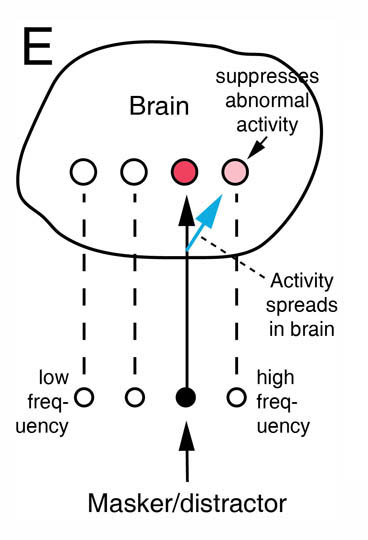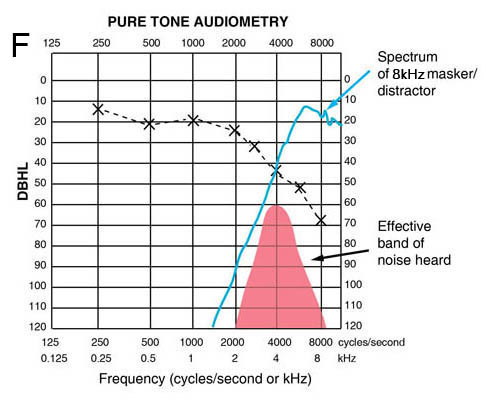4.
Masking, relaxing, and distracting sounds, and tinnitus self-help
In
addition to sounds that are specifically tailored to mask or distract
from tinnitus, it is a good idea to listen to sounds that are relaxing
and soothing. Tinnitus is also often accompanied by
hyperacusis,
in which
external sounds seem excessively loud. This can be countered by sound
enrichment of the daily environment. The enrichment can come from a
commercially-available environmental sound generator (set for instance
to make the sound of bird calls, water, or other soothing natural
sounds), or downloaded from the internet. This means that we are never
faced with absolute silence, so
that the brain comes to associate sound with relaxation, and you do not
become hypersensitive to sound. It is suggested that you play these
sounds continually, both in the day, and at night when you are asleep.
If you are using your own stimuli, you need to experiment with which
work best for you.
A
simple and cheap solution is to listen to sound files through earbuds
from an MP3 player (e.g. mobile phone). Here are some sound files for
you to use, in two
categories.
First
are natural relaxing sounds. The sound
files should be played in an endless loop, with the end and start faded
into each other so that there is no break (each sound file lasts for
6-7 minutes). Choose the best file for you and adjust the loudness
until the tinnitus becomes less intrusive. To download and save the
sound file, click on the file name till it plays, and then in your
browser go to File (or Tools) > Save page as... (in Edge
rightclick
in the playback window to save file). This will save the audio as
an .mp3 file.
Birds
1 Birds 2
Night
Stream
Waterfall
The
second group are high
frequency distractors, suitable for people with high frequency hearing
loss. In these cases the tinnitus commonly sounds like a high frequency
hissing (though it can spread to a wider range of frequencies under
stress). The sounds are provided for high-frequency losses starting at 16kHz
(16,000 cycles/sec - the highest), and 14kHz, 12kHz, 10kHz,
8
kHz, 6 kHz, 4
kHz, down to 3 kHz -
the lowest). Start at 16 kHz, and work down in frequency, choosing
the highest frequency distractor that you can only just
hear through earbuds when you have the loudness on your player set
nearly at its
maximum*. Then it will
be stimulating the nerves in your ear
just on the edge of your region of hearing loss. Activity will spread
from these nerves to the nerves that have lost their own input,
so that they will not need to generate their own activity, so reducing
the tinnitus. Again,
play in an endless
loop, cross-fading so there is no break. It is again suggested that you
start by playing the sounds through earbuds for many hours/day,
including when you are asleep.
Listening with earbuds or earphones in both ears will mean that you
hear in stereo, which will increase the brain stimulation.
*The sounds are like a high
frequency twittering. If there are crackles, clicks or pops in the
sound, this
is probably because your sound system is being oversaturated. Turn the
volume down on your player and try again.
If
you wish, you can initially use these sounds as maskers. If you have a
high-frequency hearing loss, and high-frequency tinnitus, the right
masker will be able to mask out the sensation of tinnitus if you play
it so that it is a bit louder than the tinnitus. It is suggested that
you start by masking the tinnitus for about 2 weeks. By masking the
tinnitus, you will reduce the stress associated with it.

 E:
If there is high frequency loss, stimulating the ear at nearby
frequencies will allow some activity to spread (blue arrow) to the
cells that have lost their own input, and which are generating
tinnitus. They will not need to generate their own activity, and this
will suppress the tinnitus, so that the
tinnitus will have (eventually) disappeared when the masker/distractor
is turned off.
E:
If there is high frequency loss, stimulating the ear at nearby
frequencies will allow some activity to spread (blue arrow) to the
cells that have lost their own input, and which are generating
tinnitus. They will not need to generate their own activity, and this
will suppress the tinnitus, so that the
tinnitus will have (eventually) disappeared when the masker/distractor
is turned off.
F: Sample audiogram showing moderate to severe high
frequency hearing loss (worse hearing is plotted downwards) wth black
dotted lines. Blue: spectrum of the 8kHz masker/distractor sound from
this page. Red area: resulting sound now reaching the brain: it is in a
narrow frequency band with a frequency just below the main region of
hearing loss.
After this
phase, you need to start using the sounds as a distractor. Start
reducing the loudness of the masker, so that you are just able to hear
the tinnitus at the same time as the masker. Stay in this phase and
when you
become aware of the sounds, focus on listening to the masker, rather
than the
tinnitus (the masker is
now acting
as a distractor).
Maybe after a few weeks, as the tinnitus become quieter, you will be
able to turn the volume
of the masker/distractor down further, so it is still about as loud as
the
tinnitus, and again focus on the masker/distractor. In this way, you
will
gradually get used to the sound
of the tinnitus in a non-threatening way, and the tinnitus will start
to become quieter. Eventually, the tinnitus will cease to be a problem,
and may disappear completely.
Tinnitus self-help
is quite feasible in straightforward cases. These webpages contain the
information you need to know to deal with tinnitus in these cases (e.g.
if Tinnitus Retraining Therapy is not available in your area, or not
available at a reasonable rate). However, it is always suggested that
you start with a full audiometric examination by a qualified clinical
audiologist. In addition, you may find it valuable to have experience
with Cognitive Behaviour Therapy, in addition to a range of relaxation
techniques.
It
is quite possible that the tinnitus will reappear from time to time,
maybe in times of stress. However it is not likely to be as bad as the
first time. But now you have the techniques to deal with it, so you
repeat the process, and the tinnitus is likely to quickly disappear
again.
Page 5: Other
reading and resources:
Back to Introduction.
Back to Hearing Page.

